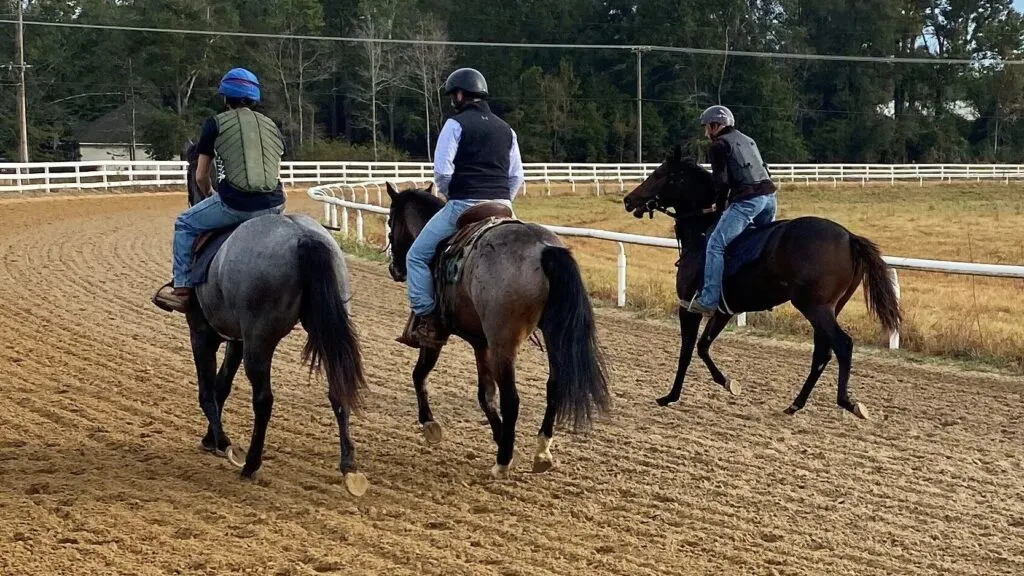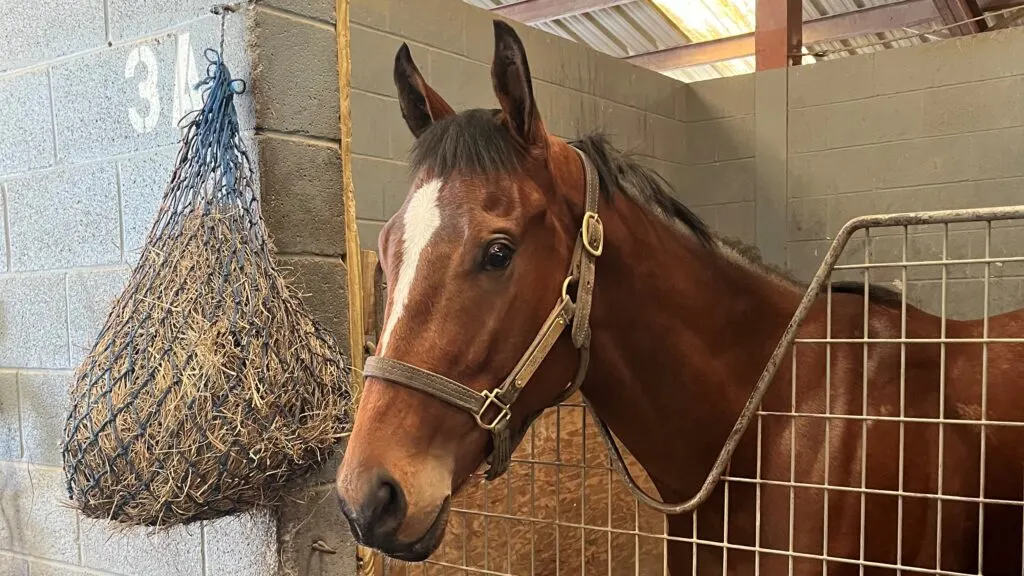Last updated: April 12, 2024
Training horses for speed involves more than just speedwork; it’s about ensuring their well-being and happiness. Successful training combines coaching, medical care, and building a strong, supportive relationship with each horse.
In this article, I’ll cover three essential parts of racehorse training. First, I’ll cover Basic Training – how young horses learn the basics of racing. It’s like horse school, where they learn to run, listen to commands, and build strong muscles.
Next, I’ll explore Advanced Techniques. This section is like advanced lessons for horses, where they learn special skills to race even better and faster. We’ll examine some tools and smart strategies used by experts.
Lastly, we’ll explore Health and Safety to understand how trainers and caretakers ensure that horses stay in top shape and don’t get hurt. This part is super important because a healthy horse is a happy and fast racer.

Understanding Horse Speed
- Genetics in Speed: Genetics play a crucial role in a horse’s potential for speed. Certain breeds, like Thoroughbreds, are genetically predisposed to run faster due to their muscle composition and cardiovascular efficiency.
- The Importance of Conditioning: Conditioning is essential for maximizing a horse’s speed. Tailored training programs that enhance cardiovascular health, muscle strength, and stamina are key.
Basic Training: Building a Solid Foundation for Racehorses
It’s crucial to start with groundwork to establish trust and communication. This includes leading exercises, teaching the horse to respond to basic commands like stop, go, and turn, and getting accustomed to being handled all over. Consistency and patience here sets the stage for all future training.
Ground Training
We start training with basic exercises like lunging to improve the horse’s balance and obedience while introducing them to the concept of working in circles around us. Next, I work on desensitization to ensure the horse remains calm in various situations.
Early saddle and bridle training should be introduced gradually, focusing on getting the horse comfortable with the gear before starting any riding work. These foundational steps are critical for developing a well-trained horse ready for more advanced training.
Basic Training Techniques
We take horses to the training track after they are comfortable with the saddle and understand basic commands. Here, they learn important basics like changing leads, gait transitions, and standing at the starting gates.
We train them at different speeds and distances to build their speed and stamina. This part is crucial to prepare them for actual races.
Building Physical and Mental Endurance
Training horses goes beyond physical fitness; it’s also about building mental strength. We expose them to different tracks and let them train with older horses. This teaches them about racing and helps them stay calm and focused.
Over time, they become physically stronger and mentally prepared for races, ready to face any challenge on the racetrack. This approach helps young horses grow into potential champions.

Advanced Techniques – Elevating the Performance of Racehorses
Advanced techniques are new ways to train horses to run faster and perform better while reducing the risk of injury. Using modern tools like GPS and heart rate monitors helps horses perform better. These methods make the horse and rider a stronger team.
Step-by-Step Advanced Workouts.
For advanced workouts, focus on interval training, alternating between intense exercises and rest periods. This method boosts both speed and endurance. Begin with short, intense exercises like sprints for 5 minutes, followed by slower recovery phases.
Pay attention to your horse’s response to gradually increase the challenge. This approach ensures horses build strength safely, preparing them for competitive racing.
Using Technology and Equipment to Boost Horse Performance
In our training, we primarily use heart rate monitors to ensure our horses are in peak condition without being overworked. This tool gives us real-time data about their physical state during exercise, allowing us to adjust their training intensity accordingly.
While we incorporate swimming as a low-impact way to build strength and stamina, especially for horses coming off an injury, we don’t use treadmills. I’ve read that treadmills offer a controlled environment for specific training needs, but their high cost and availability limit their use to more high-end facilities.
Training racehorses to be their fastest and strongest takes some really cool tools and techniques! One of them is the treadmill, which helps horses get great exercise safely and steadily. Then, there’s the equine pool, like a swimming workout for horses, which helps them build muscle without putting too much stress on their joints.
Refining Rider-Horse Communication for Peak Performance
Advanced handling and riding techniques focus on refining the synergy between the exercise jockey and horse, with jockeys employing specialized techniques to guide, control, and coax the best performance from their equine counterparts.
Mastery in subtle communication through reins, seat, and leg pressures ensures that the jockey can seamlessly instruct and encourage the horse during races, forging a partnership where both athletes work in impeccable unity, each amplifying the other’s efforts.
Specialized Training for Different Racing Formats
Different racing formats demand distinct training approaches. Specialized training involves tailoring techniques and regimes for short sprints versus distance races, considering factors like speed, stamina, and energy conservation.
Additionally, preparing horses for varying track surfaces and conditions – be it turf, dirt, or synthetic – requires nuanced adjustments in training to ensure that they can adeptly handle and excel across diverse racing environments.
This segment of a racehorse’s training journey encapsulates a blend of sophisticated regimes, state-of-the-art equipment, adept handling, and format-specific preparation, converging to elevate their performance, pushing boundaries, and setting new pinnacles of racing excellence.

Nutrition and Health Management
Keeping our racehorses healthy and safe is a top priority in training. Let’s explore how to care for them and ensure they always feel their best in body and mind.
Diet for Enhancing Performance: A well-balanced diet is crucial for racehorses to perform at their best. Focus on high-quality forage, grains, and supplements that meet the horse’s energy, vitamin, and mineral needs. Tailor the diet to the horse’s training intensity and recovery requirements.
Injury Prevention and Care: Regular veterinary check-ups, proper warm-up routines, and cooldowns are essential to prevent injuries. Immediate and appropriate care for any injuries, alongside rest and rehabilitation, ensures quick recovery and maintains the horse’s health and performance levels.
Mental Health and Stress Management
A horse’s mental well-being is crucial. Identifying and managing stress, like adjusting to new environments or maintaining routines, is key. Simple adjustments, such as stall placement to keep companions in view, can maintain calmness.
Regular turnouts, which allow horses to unwind and engage in natural behaviors, are essential for mental health and support a racehorse’s overall success and longevity in its career.

Monitoring Progress and Adjusting Techniques,
Regularly checking a horse’s speed and stamina with timed works helps us see where they excel and where they can improve. I start working them at shorter distances, like 3/8 of a mile, then gradually increase.
This way, I can find their optimal racing distance. When increasing training intensity, it’s important to do so carefully, ensuring the horse is physically and mentally ready and always keeping their well-being in mind.
FAQs
What is the best age to start training a racehorse?
Racehorses typically begin training at around 18 months old, but the precise start can vary based on the individual horse’s development and breed. Early training focuses on basic handling and gradually introduces more specific race training.
How fast can a horse run?
On average, horses can run between 25 to 30 miles per hour. However, some breeds, like Thoroughbreds, used in racing, can reach speeds over 40 miles per hour under the right conditions.
How often should a horse be trained?
The frequency of training a horse can vary based on its fitness level, age, and training goals. Generally, a balanced training schedule includes 5 to 6 days a week, allowing at least one day for rest. It’s important to adjust the intensity and type of training to fit the horse’s individual needs and avoid overtraining.
Conclusion: Training Horses For Speed
Focusing on physical and mental health is essential for developing horses to run fast, and using advanced tools and techniques can significantly enhance a horse’s performance. Regular evaluations help tailor training for continuous improvement.
Remember, managing stress and ensuring well-being are as important as physical training. For trainers, ongoing learning and adapting new methods will ensure your horses reach their full potential, like Secretariat, one of the fastest horses in history. Keep exploring and applying new insights for the best outcomes. For more details and tips, subscribe to our newsletter.

Additional Resources
Books and Articles for Further Reading
- Training the Racehorse – Tim Fitzgeorge-Parker
- The Man Who Listens to Horses – Monty Roberts
- Training Thoroughbred Horses – Preston M. Burch
- Understanding Equine Nutrition: Your Guide to Horse Health and Wellness – Karen Briggs
- “Racehorse Fitness Training” – Article in AQHA
Reading further from experts and individuals who have crafted histories with horses provides a richer, deeper perspective into the nuanced world of equine training and management.
Online Courses and Workshops on Equine Training
- Components of an Equine Diet (Course offered by University of Florida)
- Principles of Equine Management (Offered by the University of Tennessee)
- Equine Anatomy & Physiology Course (offered by Racing Academy)
- Understanding Equine Behavior (offered by When Horses Choose)
- Various workshops and webinars on The Horse (www.thehorse.com)
Online courses and workshops can directly equip you with additional knowledge and new horse training methodologies from equine science and management experts.
Directory of Experts and Training Centers
- National Training Centers:
- Highlander Training Center (Sulpher Springs, Texas)
- Fair Hill Training Center (Elkton, MD)
- International Training Centers:
- Godolphin’s Darley Flying Start (With locations in Ireland, the UK, the USA, and Australia)
- British Racing School (Newmarket, UK)
- Experts:
- Kentucky Equine Research (Lexington, KY)
- Jim Bolger is a renowned horse trainer and breeder with a rich history in thoroughbred racing.
Investing time in exploring various training centers, learning from seasoned experts, and perhaps even enrolling in workshops or short courses they might offer will undeniably deepen your understanding and skills in equine training and management. Learn about the most famous racehorses.
